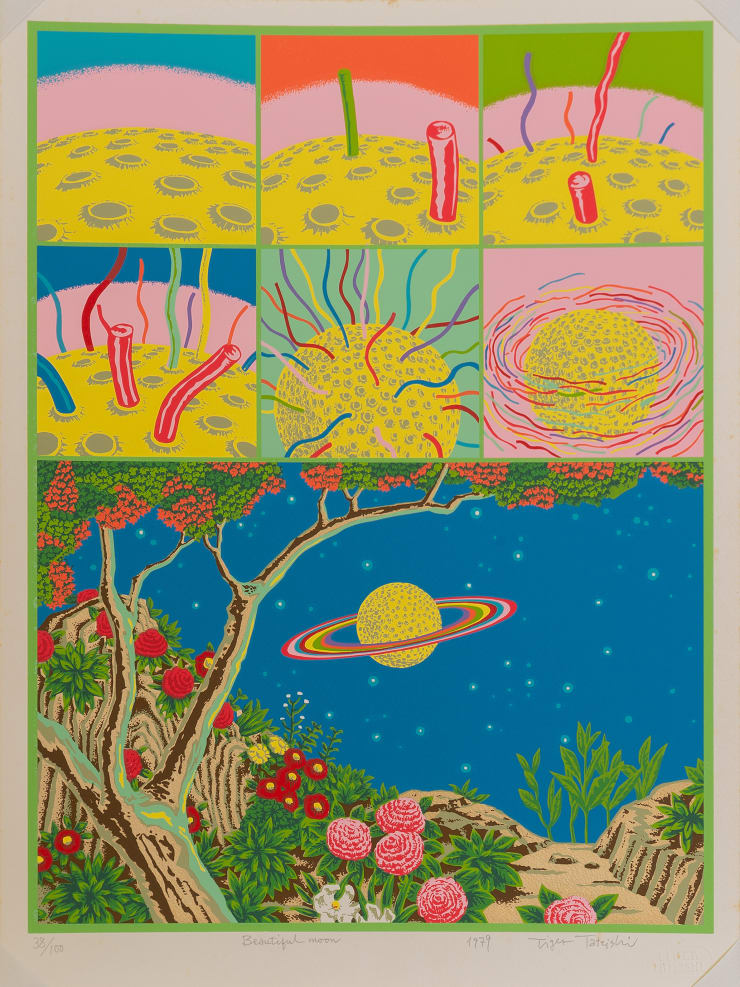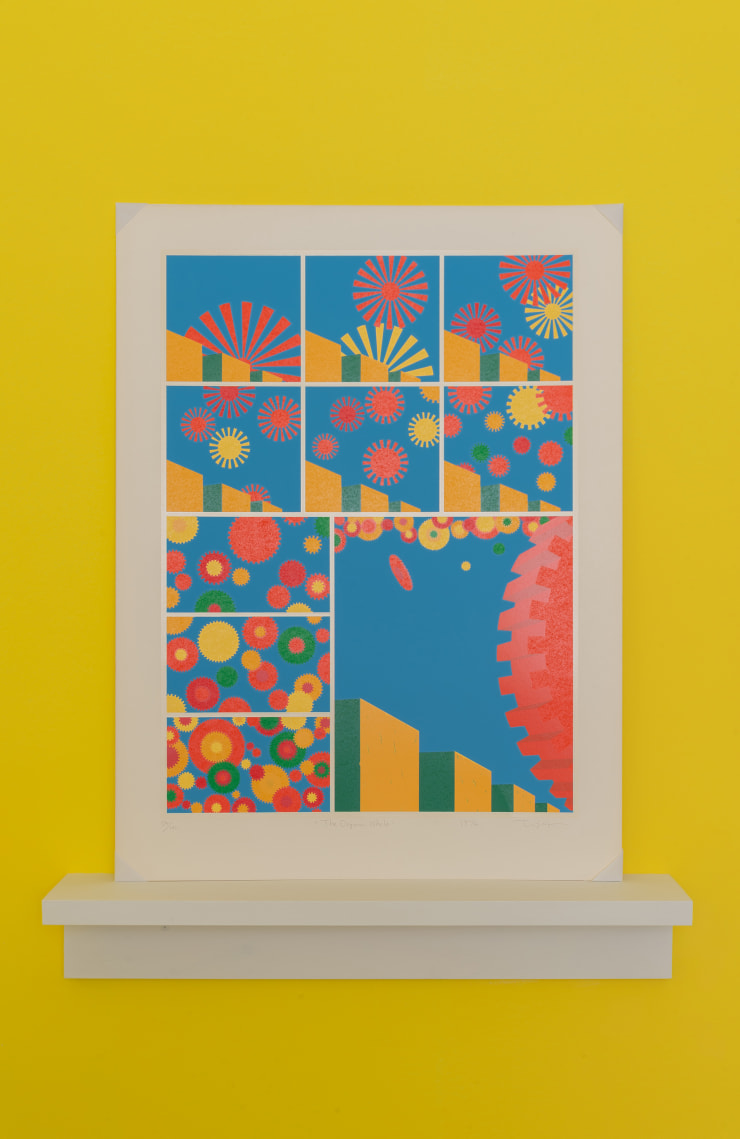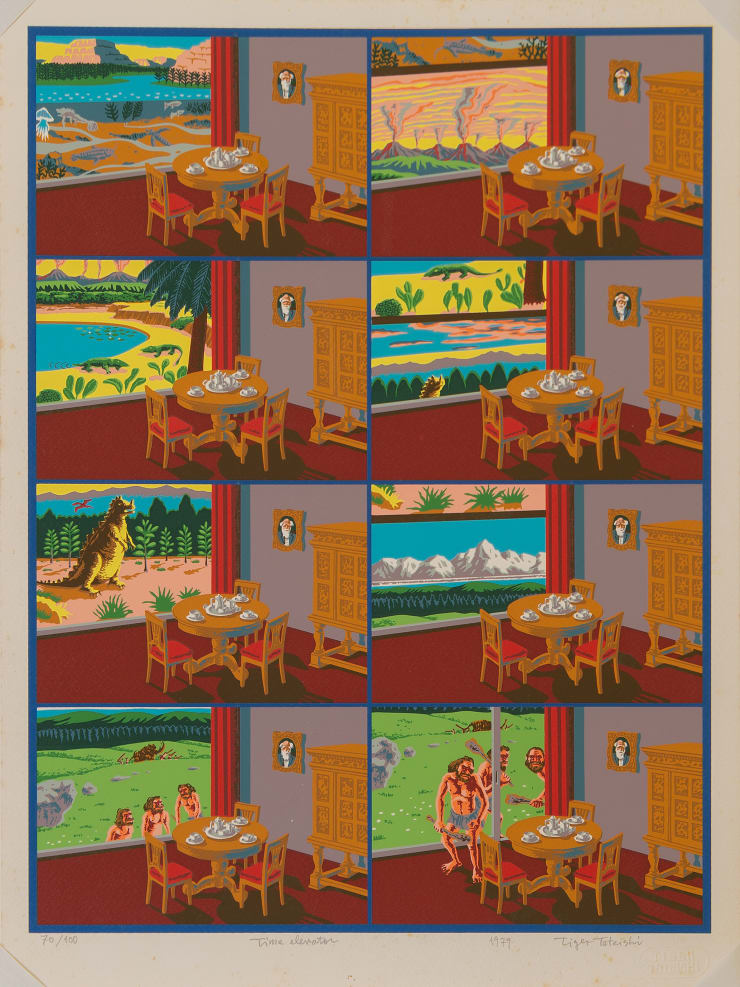Tiger Tateishi
Tiger Tateishi: Enchanted by Disney cartoons and American movies in his youth, Tiger Tateishi was later drawn to Mad Magazine and stories by science fiction authors, Ray Bradbury, Arthur C. Clarke, and Robert Sheckley. He began his art career in 1963, producing “Pop Art” paintings from a Japanese point of view, colliding Japan’s iconic Mt. Fuji, Godzilla, and Samurai together with international icons such as Mao Tse Tung, an atomic mushroom cloud, MAD Magazine’s Alfred E. Neuman, Coca-Cola, the American Western landscape and KKK processions. To parody the tourism initiatives of the 1964 Tokyo Olympic Games, Tateishi founded The Institute of Tourist Art (1964-66), creating works which operated off the Mt. Fuji as beloved national symbol and tourism moneymaker. His first solo exhibition of the same year was titled Accumulated Civilization, an idea which echoes through his oeuvre.
With the desire to draw “nonsense cartoons”, then unpopular in Japan, Tateishi and his wife Fumiko left for Milan in 1969, drawn to the city of Futurism. Notably, their move was concurrent with other new frontiers felt globally; Stanley Kubrick’s 2001: A Space Odyssey (1968) and the Apollo 11 first moon landing. As a consummate absorber of his surroundings, Tateishi met Giorgio de Chirico (whose perspectival style he had appropriated earlier in 1964) and merged de Chirico-style images into a new storyboard sequencing in his paintings. This format, usually only seen in comics, proved ideal for making paintings of Sci-Fi narratives. An employee of Ettore Sottsass’s saw these works and introduced the architect/designer to Tateishi and an extraordinary group of drawings were produced setting Sottsass’s early proposals for fantastical and erotic architectural forms in outer space terrains. While attributed to Sottsass, these works are often signed “Tiger pinxit”, Latin for “Tiger painted it”. Tateishi also started making silkscreen prints from the early 1970s in Milan, a selection of which are on view. These works, and Rotating Fuji incorporate the story-board format which Tateishi continued to utilize in paintings, drawings and artist’s books throughout his career.
Tiger (Kōichi) Tateishi was born in 1941, Fukuoka Prefecture, Japan. He passed away in 1998. He received a degree from Musashino University Junior College of Art and Design in 1963. Tateishi’s vast oeuvre includes oil painting, prints, comics, illustration, children’s books, and ceramics. Since 1963, the artist has had numerous solo and group exhibitions in Japan, Europe, and the United States. After his death, two retrospectives were organized: Tiger Tateishi: The Endless Tiger at Tagawa City Art Museum, 1999 and Metamorphose Tiger: Walking through the Labyrinth with Tiger Tateishi, O Museum,1999 (cat.). Tateishi was featured in a two-artist shows, The World is Strange! The Manga and painting of Tiger Tateishi and Yuichi Yokoyama, Hiroshima City Museum of Contemporary Art, 2017. Recent group exhibitions include Tokyo 1955-1970: A New Avant Garde, 2012; The Museum of Modern Art, New York, Japanorama: A New Vision on Art Since 1970,Centre Pompidou-Metz, 2018. A touring Tateishi survey exhibition is planned for 2020/2021 appearing at Chiba City Museum of Art, Aomori Museum of Art, Takamatasu Art Museum and The Museum of Modern Art, Saitama.
-
 Tiger TateishiBeautiful Moon, 1979Silk screen on paperimage: H16-9/16 x W12-7/16 inches
Tiger TateishiBeautiful Moon, 1979Silk screen on paperimage: H16-9/16 x W12-7/16 inches
sheet: H18-1/8 x W13-7/16 inches
image: H42 x W31.5 cm
sheet: H46 x W34 cm -
 Tiger TateishiBig Diamond, 1979Silk screen on paperimage size H16-9/16 x W12-7/16 inches, sheet size H18-1/8 x W13-7/16 inches,
Tiger TateishiBig Diamond, 1979Silk screen on paperimage size H16-9/16 x W12-7/16 inches, sheet size H18-1/8 x W13-7/16 inches,
image size H42 x W31.5 cm, sheet size H46 x W34 cm -
 Tiger TateishiCabbage Moon, 1979Silk screen on paperimage size H16-9/16 x W12-7/16 inches, sheet size H18-1/8 x W13-7/16 inches,
Tiger TateishiCabbage Moon, 1979Silk screen on paperimage size H16-9/16 x W12-7/16 inches, sheet size H18-1/8 x W13-7/16 inches,
image size H42 x W31.5 cm, sheet size H46 x W34 cm -
 Tiger TateishiCoral Moon, 1978Silk screen on paperimage size H16-9/16 x W12-7/16 inches, sheet size H18-1/8 x W13-7/16 inches,
Tiger TateishiCoral Moon, 1978Silk screen on paperimage size H16-9/16 x W12-7/16 inches, sheet size H18-1/8 x W13-7/16 inches,
image size H42 x W31.5 cm, sheet size H46 x W34 cm -
 Tiger TateishiCubic Worlds, 1973Silk screen on paperimage size H26-7/16 x W19-5/16 inches, sheet size H29-15/16 x W22-1/2 inches,
Tiger TateishiCubic Worlds, 1973Silk screen on paperimage size H26-7/16 x W19-5/16 inches, sheet size H29-15/16 x W22-1/2 inches,
image size H67 x W49 cm, sheet size H76 x W57 cm -
 Tiger TateishiMoon Grows to the Moon, 1981Silk screen on paperimage size H25-1/4 x W18-1/2 inches, sheet size H32-11/16 x W25-5/8 inches,
Tiger TateishiMoon Grows to the Moon, 1981Silk screen on paperimage size H25-1/4 x W18-1/2 inches, sheet size H32-11/16 x W25-5/8 inches,
image size H64 x W47 cm, sheet size H83 x W65 cm -
 Tiger TateishiMoon's Satisfaction, 1979Silk screen on paperimage size H16-9/16 x W12-7/16 inches, sheet size H18-1/8 x W13-7/16 inches,
Tiger TateishiMoon's Satisfaction, 1979Silk screen on paperimage size H16-9/16 x W12-7/16 inches, sheet size H18-1/8 x W13-7/16 inches,
image size H42 x W31.5 cm, sheet size H46 x W34 cm -
 Tiger TateishiPeacock Moon, 1979Silk screen on paperimage size H16-9/16 x W12-7/16 inches, sheet size H18-1/8 x W13-7/16 inches,
Tiger TateishiPeacock Moon, 1979Silk screen on paperimage size H16-9/16 x W12-7/16 inches, sheet size H18-1/8 x W13-7/16 inches,
image size H42 x W31.5 cm, sheet size H46 x W34 cm -
 Tiger TateishiPisa, 1979Silk screen on paperimage size H16-9/16 x W12-7/16 inches, sheet size H18-1/8 x W13-7/16 inches,
Tiger TateishiPisa, 1979Silk screen on paperimage size H16-9/16 x W12-7/16 inches, sheet size H18-1/8 x W13-7/16 inches,
image size H42 x W31.5 cm, sheet size H46 x W34 cm -
 Tiger TateishiPlanets Blossom, 1973Silk screen on paperimage size H24-13/16 x W18-1/2 inches, sheet size H29-3/4 x W22-1/2 inches,
Tiger TateishiPlanets Blossom, 1973Silk screen on paperimage size H24-13/16 x W18-1/2 inches, sheet size H29-3/4 x W22-1/2 inches,
image size H63 x W47 cm, sheet size H75.5 x W57 cm -
 Tiger TateishiRevolving Fuji (回転富士), 1991Oil on canvas.89-1/2 x 63 inches
Tiger TateishiRevolving Fuji (回転富士), 1991Oil on canvas.89-1/2 x 63 inches
227.3 x 160 cm -
 Tiger TateishiThe First Suggestion, 1979Silk screen on paperimage size H16-9/16 x W12-7/16 inches, sheet size H18-1/8 x W13-7/16 inches,
Tiger TateishiThe First Suggestion, 1979Silk screen on paperimage size H16-9/16 x W12-7/16 inches, sheet size H18-1/8 x W13-7/16 inches,
image size H42 x W31.5 cm, sheet size H46 x W34 cm -
 Tiger TateishiThe Machine, 1978Lithographsheet size H18-1/2 x W18-1/8 inches,
Tiger TateishiThe Machine, 1978Lithographsheet size H18-1/2 x W18-1/8 inches,
sheet size H47 x W46 cm -
 Tiger TateishiThe Organic Whole, 1974Silk screen on paperimage size H26-7/16 x W19-5/16 inches, sheet size H29-15/16 x W22-1/2 inches,
Tiger TateishiThe Organic Whole, 1974Silk screen on paperimage size H26-7/16 x W19-5/16 inches, sheet size H29-15/16 x W22-1/2 inches,
image size H67 x W49 cm, sheet size H76 x W57 cm -
 Tiger TateishiTime Elevator, 1979Silk screen on paperimage size H16-9/16 x W12-7/16 inches, sheet size H18-1/8 x W13-7/16 inches,
Tiger TateishiTime Elevator, 1979Silk screen on paperimage size H16-9/16 x W12-7/16 inches, sheet size H18-1/8 x W13-7/16 inches,
image size H42 x W31.5 cm, sheet size H46 x W34 cm -
 Tiger TateishiUntitled (Red Awakening), 1964Oil on canvas.H6-13/16 x W8-1/16 inch
Tiger TateishiUntitled (Red Awakening), 1964Oil on canvas.H6-13/16 x W8-1/16 inch
H17.3 x W20.4cm

















